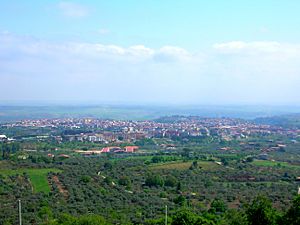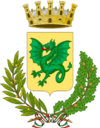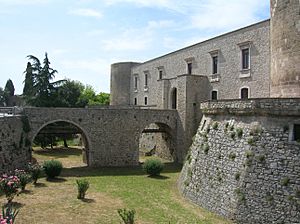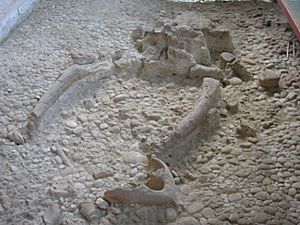Venosa facts for kids
Quick facts for kids
Venosa
|
||
|---|---|---|
| Città di Venosa | ||
 |
||
|
||
| Country | Italy | |
| Region | Basilicata | |
| Province | Potenza (PZ) | |
| Area | ||
| • Total | 170.39 km2 (65.79 sq mi) | |
| Elevation | 415 m (1,362 ft) | |
| Population
(31 December 2015)
|
||
| • Total | 11,863 | |
| • Density | 69.623/km2 (180.322/sq mi) | |
| Demonym(s) | Venosini | |
| Time zone | UTC+1 (CET) | |
| • Summer (DST) | UTC+2 (CEST) | |
| Postal code |
85029
|
|
| Dialing code | 0972 | |
| Patron saint | St Roch (formerly St Felix of Thibiuca) |
|
| Saint day | August 16 | |
Venosa is a charming town located in southern Italy, in the region of Basilicata. It is known as one of "The most beautiful villages of Italy." The town is surrounded by other small communities like Barile, Ginestra, and Lavello.
Contents
History of Venosa
Ancient Times
Long ago, the Romans called this city Venusia, which means "City of Venus". They believed it was founded by a hero named Diomedes after the Trojan War. He supposedly built the town to make Aphrodite (the Greek name for Venus) happy again, as her favorite city, Troy, had been destroyed.
The Romans took control of Venosa in 291 BC after a war called the Third Samnite War. It became a Roman settlement because it was in a very important spot between two regions, Apulia and Lucania. About 20,000 soldiers were sent there because of its military importance.
During the wars against Hannibal, Venosa stayed loyal to Rome. In 200 BC, more settlers were sent to replace those lost in the war. Later, in 190 BC, a famous Roman road called the Appian Way was extended to reach the town.
Venosa was involved in the Social War and was later taken back by a Roman general. It then became a municipium, which was a town with its own local government. In 43 BC, its land was given to Roman soldiers who had served in the army.
The famous Roman poet Horace was born here in 65 BC. His family's land in Venosa was taken by Emperor Augustus after a civil war. This happened to many families across Italy. Venosa remained an important stop on the Via Appia during the Roman Empire.
Later Ancient Times
In later ancient times, Venosa had the second-largest Jewish community in Italy, after Rome. We don't know exactly when they first settled there, but they lived in Venosa for many centuries.
The Jewish people in Venosa buried their dead in underground tunnels called catacombs. These catacombs were likely used between the 4th and 6th centuries AD. When the catacombs were no longer used, they started burying people on the hill above them. Some tombstones from the 9th century can still be seen today, built into the walls of a nearby church. The writings on these stones were mostly in Greek and Latin at first, but later changed to Hebrew. Jewish symbols, like the menorah, were often used in their art. Even though they had their own distinct culture, the Jewish community was an active part of the town. Jewish officials even held public jobs.
After the Western Roman Empire fell, Venosa was attacked by a group called the Heruls. In 493 AD, it became an important center for the Ostrogothic kingdom in Italy. Later, this role was moved to another town. The Lombards made Venosa a special administrative area around 570-590 AD.
Middle Ages
In 842, Venosa was attacked by the Saracens, who were later driven out by Emperor Louis II.
Next, the Byzantines ruled Venosa. But they lost control in 1041 after being defeated by the Normans. Under the Normans, Venosa was given to a leader named Drogo of Hauteville. In 1133, the town was attacked and burned by Roger II of Sicily.
Later, Frederick II had a castle built in Venosa. This castle was meant to hold the money and important documents of the Kingdom of Sicily.
Frederick's son, Manfred of Sicily, might have been born here in 1232. After Manfred's defeat, the Hohenstaufen family was replaced by the Angevines. King Charles of Anjou made Venosa a county and gave it to his son Robert.
Modern Era
After being ruled by several different noble families, Venosa became part of the Orsini lands in 1453. Count Pirro Del Balzo, who married into the Orsini family, built a new castle between 1460 and 1470. He also built a cathedral.
During the time of Aragonese rule, the Gesualdo family took control in 1561. This family included the famous musician Carlo Gesualdo.
Even though a terrible plague reduced its population, Venosa had a rich cultural life under the Gesualdos. Besides Carlo Gesualdo, other important people from this time include the poet Luigi Tansillo (1510–1580) and the lawyer Giovanni Battista De Luca (1614–1683).
Venosa was involved in a revolt in 1647 led by Masaniello. The Gesualdo family was later followed by the Ludovisi and Caracciolo families.
Venosa has a history of supporting republican ideas. It played a role in peasant revolts and the Carbonari movement in the early 1800s. In 1849, there was a conflict between powerful landowners and people who supported peasants' rights. This was stopped by troops from Naples.
In 1861, after the Kingdom of the Two Sicilies fell during the Italian unification, Venosa was taken over by groups of brigands. These groups were led by Carmine Crocco and wanted to bring back the old ruling family, the Bourbons, in Basilicata.
Main Sights
- The Aragonese Castle was built in 1470 by Pirro del Balzo Orsini. It has a square shape with four round towers. You can see the del Balzo family symbol, a shining sun, on the western towers. Carlo and Emanuele Gesualdo later turned it into a home. They added an indoor balcony and a new wing. Since 1612, it has been home to a famous academy. Today, it holds the National Museum of Venosa, which opened in 1991. The museum displays ancient Roman artifacts and other findings up to the 9th century. Before the entrance, there is a fountain given by King Charles I of Anjou.
- Many pieces of old Roman buildings are built into the walls of the Cathedral. This church was also built by Pirro del Balzo around 1470.
- The Abbey Church of SS. Trinità is a very old and interesting church. It was officially opened in 1059 by Pope Nicholas II. Later, it was given to the Knights of Saint John. Inside the main part of the church, you can find the tomb of Alberada, who was the first wife of Robert Guiscard. A special stone also remembers the great Norman brothers: William Iron Arm, Drogo, Humfrey, and Robert Guiscard. Their bones rest together in a simple stone box. The church also has some old paintings from the 1300s. Behind this church, there is a larger church that was started around 1150. It was designed by a French architect but was never fully finished. The old Roman amphitheater nearby provided the stones for its walls.
- The Baroque Church of the Purgatory (also called San Filippo Neri) is another beautiful church in Venosa.
- The Archaeological Area of Notarchirico is located near the town. This area shows evidence of human life from 600,000 to 300,000 years ago, during the Palaeolithic period (Old Stone Age). Scientists have found bones of ancient animals here, including types of elephants, bisons, and rhinoceroses that are now extinct. They also found a piece of a leg bone from an early human, Homo erectus.
- The Jewish catacombs are underground burial sites with writings in Hebrew, Greek, and Latin. These show how important the Jewish community was in Venosa during the 4th and 5th centuries.
- You can still see parts of the ancient city walls and an amphitheater (a large outdoor arena) from Roman times. Many old inscriptions have also been found here.
People from Venosa
- Horace (65 BC – 8 BC): A famous Roman poet.
- Manfred (1232–1266): A king of Sicily.
- Bartolomeo Maranta (1500–1571): A doctor, plant expert, and writer.
- Luigi Tansillo (1510–1568): A poet.
- Carlo Gesualdo (1566–1613): A music composer, lute player, and nobleman.
- Giovanni Battista de Luca (1614–1683): A lawyer and cardinal.
- Giacomo Di Chirico (1844–1883): A painter.
- Mario de Bernardi (1893–1959): A colonel and pilot.
- Cinzia Giorgio (b. 1975): A writer.
Twin Towns
 Tortolì, Italy
Tortolì, Italy Bernalda, Italy
Bernalda, Italy
See also
 In Spanish: Venosa para niños
In Spanish: Venosa para niños





